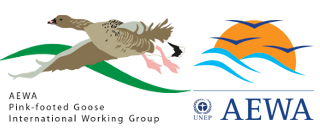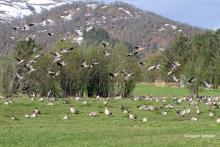Current Size: 76%
Improving the allocation of subsidies to alleviate goose-agricultural conflicts
Summary
In 2006 a regional subsidy scheme was introduced in Nord-Trøndelag, central Norway to allow pink-footed geese to forage on pasture and arable lands during their stop-over stays whilst on spring migration. In previous years intensive feeding on pastures and newly sown cereal fields were the cause of escalating conflicts with farmers. To aid the identification of fields most susceptible to goose grazing a system was developed for ranking all fields in the region according to their suitability for pink-footed geese. This ecologically based tool was used by the regional authorities, from 2009 onwards, as the basis for prioritizing and allocating subsidies to farmers to create areas to accommodate the geese (refuge areas).
In 2010 field research was conducted to evaluate the efficiency of this prioritization, in terms of how subsidies were actually used. This article presents the results, confirming that the ecologically based prioritization tool resulted in a high efficiency of funds allocated for subsidies; effectively creating refuge areas. The article also concludes that close dialogue between scientists and managers was one of the keys to the success of the scheme and its development. Furthermore it is recognised that the prioritization tool and the subsidy scheme will need continuing adjustments, as well as user collaborations, as goose populations continue to grow and to account for an adaptive dual strategy to attract geese to certain fields whilst also scaring them from others. The article is published online with open-access in AMBIO.
For more details please see the attached report:















